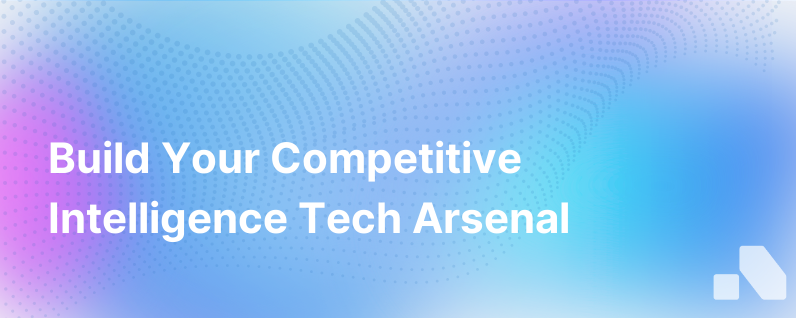Competitive Intelligence Tech Stack
Published on November 29, 2023 by David Zhang
In today’s hyper-competitive business landscape, B2B sales teams require more than charisma and product knowledge to close deals. Intelligence—about competitors, market dynamics, and business opportunities—is the ammunition sales teams need. This is where a robust Competitive Intelligence (CI) Tech Stack becomes mission-critical for businesses looking to gain a leading edge.
Why is Competitive Intelligence Crucial in B2B Sales?
CI informs strategic decisions, helping organizations understand their position in the market and how to advance. Without competitive intelligence, businesses risk making decisions in a vacuum, ignoring potential threats and untapped opportunities.
For sales teams, CI isn't just about knowing the competitors' product features; it’s about understanding their go-to-market strategies, pricing models, customer feedback, and innovations that could change the sales game altogether.
Building the Competitive Intelligence Tech Stack
The B2B CI Tech Stack combines various tools that work in tandem to provide a comprehensive view of the competitive landscape. Here’s a glance at the components that serve as the building blocks of this stack.
1. CI Platforms
CI platforms are the centerpiece of the tech stack. They automate data gathering, filtering noise to extract actionable insights. Crayon and Kompyte are popular options, known for their AI-driven insights and ease of building competitive comparisons.
2. CRM Systems
Customer Relationship Management (CRM) systems like Salesforce or HubSpot must be seamlessly integrated within the CI Tech Stack. This empowers sales teams to access competitor data within their existing workflows, providing context for each sales interaction.
3. Sales Enablement and Intelligence Tools
Sales Enablement platforms like Seismic or Highspot promote efficient access to competitive battlecards and collaterals, ensuring sales reps are primed for any competitive conversation. Meanwhile, Sales Intelligence tools like LeadIQ and ZoomInfo can alert teams to market changes that impact prospect needs.
4. Conversation Intelligence Software
Another vital aspect is conversation intelligence software such as Gong or Chorus.ai. These tools analyze sales calls to provide insights into what competitors are being mentioned in sales conversations and how prospects react to various sales tactics.
5. Market and Business Intelligence
Market intelligence services like CB Insights or Forrester offer broader industry insights. Owler for tracking company news, and SimilarWeb for assessing digital landscapes are crucial for understanding how competitors are positioning themselves in the market.
6. Social Listening Tools
Brandwatch and Hootsuite monitor brand mentions online. Social listening is particularly insightful as it unpacks sentiment and discussions around competitors’ products and services.
7. Communication and Collaboration Tools
Finally, platforms like Slack or Microsoft Teams ensure that competitive insights are communicated effectively across the team, enabling quick action and strategic alignment.
Leveraging Your Competitive Intelligence Tech Stack
To gain the maximum benefits from your CI Tech Stack, consider these best practices:
- Integration: Tools should impeccably sync with each other. This means that insights from conversation intelligence filters into CRM data, which in turn should be easily accessible through sales enablement platforms.
- Comprehensiveness: The data pooled should canvas all types of intelligence — from social chatter to in-depth market analyses.
- Real-time Updates: In a world where markets shift overnight, having real-time updates provides sales teams the ability to act quickly and decisively.
- Collaboration: Ensure the entire team can contribute to and extract insights from the CI stack. A collaborative approach often reveals blind spots and opens avenues for innovation.
- Ease of Use: If the tools aren’t user-friendly, they won’t be used. Simplistic, intuitive interfaces and user experiences are not just nice to have, they are critical.
- Training and Adaptability: Invest in training for your sales team to adeptly use these tools, and always keep an eye out for new technologies that could bolster your stack.
The implementation of a CI Tech Stack is transformative for organizations that prioritize strategic growth, market leadership, and sales excellence. It is a journey of continuous improvement, where each piece of intel refines the overall sales strategy.
In the end, it’s not just about having the tools but about harnessing their collective power to understand the context of every deal and to anticipate market moves before they happen.
Aomni - The Catalyst in Your CI Tech Stack
At Aomni, we streamline the exemplary B2B sales experience, integrating with your CI tech stack to enhance real-time account research and competitive insights. Our AI platform streamlines the intel-gathering process, channeling strategic sales content to your team with unprecedented speed and relevance—fifteen minutes is all it takes.
It’s not about replacing any single tool—it’s about enhancing and connecting them all. With Aomni, zero effort yields maximal strategic advantage. Unlock your B2B sales potential today.
Discover more insights and B2B strategies by visiting the Aomni blog.
Sources:
- How to build a tech stack for competitive intel?
- A 2023 guide to building a competitive intelligence strategy for SaaS
- The 14 Best Competitive Intelligence Tools for Market Research
- 5 Key Competitive Intelligence Trends For 2023
- Top Free Competitive Intelligence Tools in 2024
- 5 Emerging Trends in Competitive Intelligence
- Best Competitive and Market Intelligence Tools for Technology and Service Providers Reviews 2024 | Gartner Peer Insights
- What's in Your Competitive Intelligence Tech Stack? | Crayon